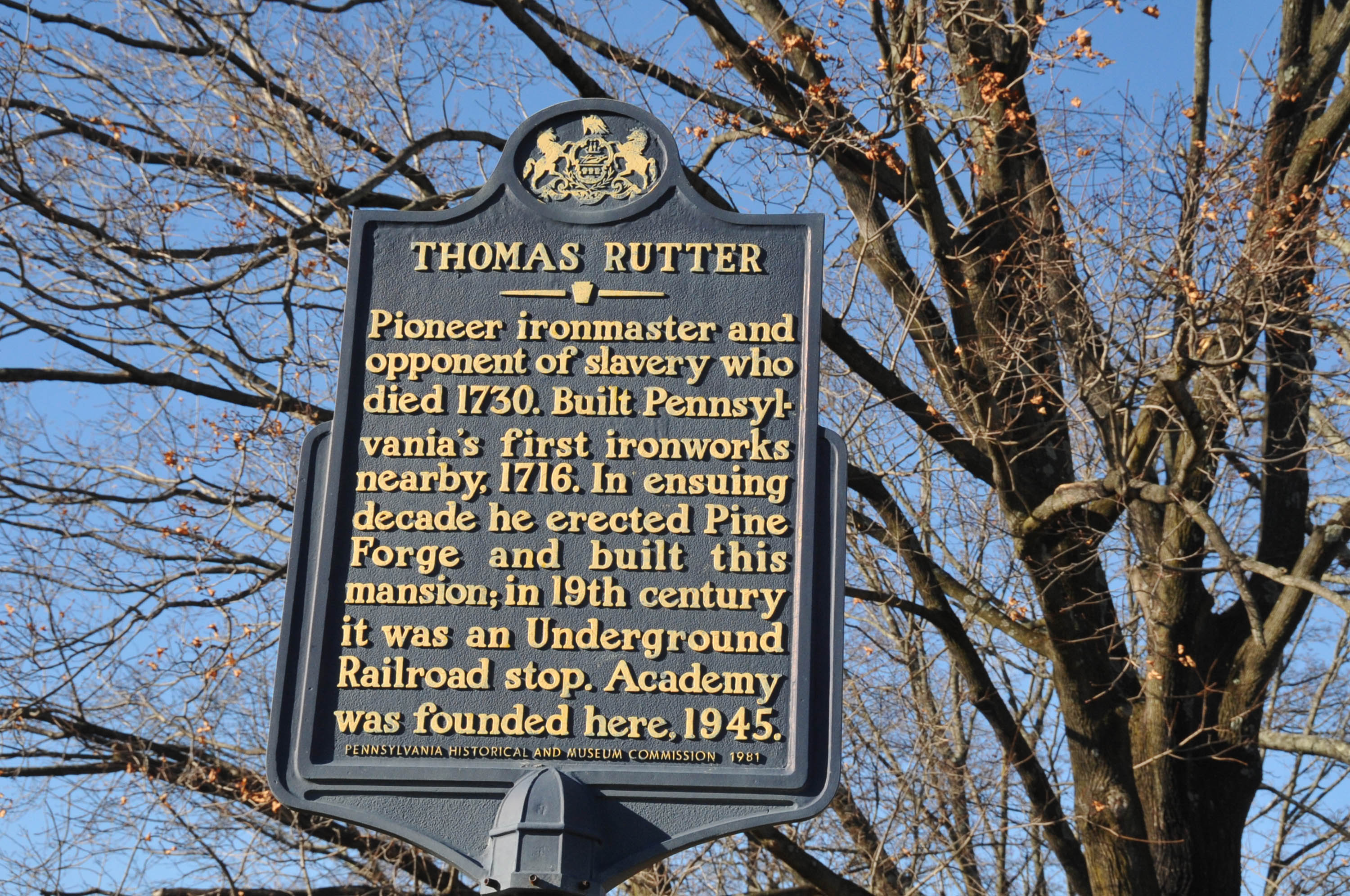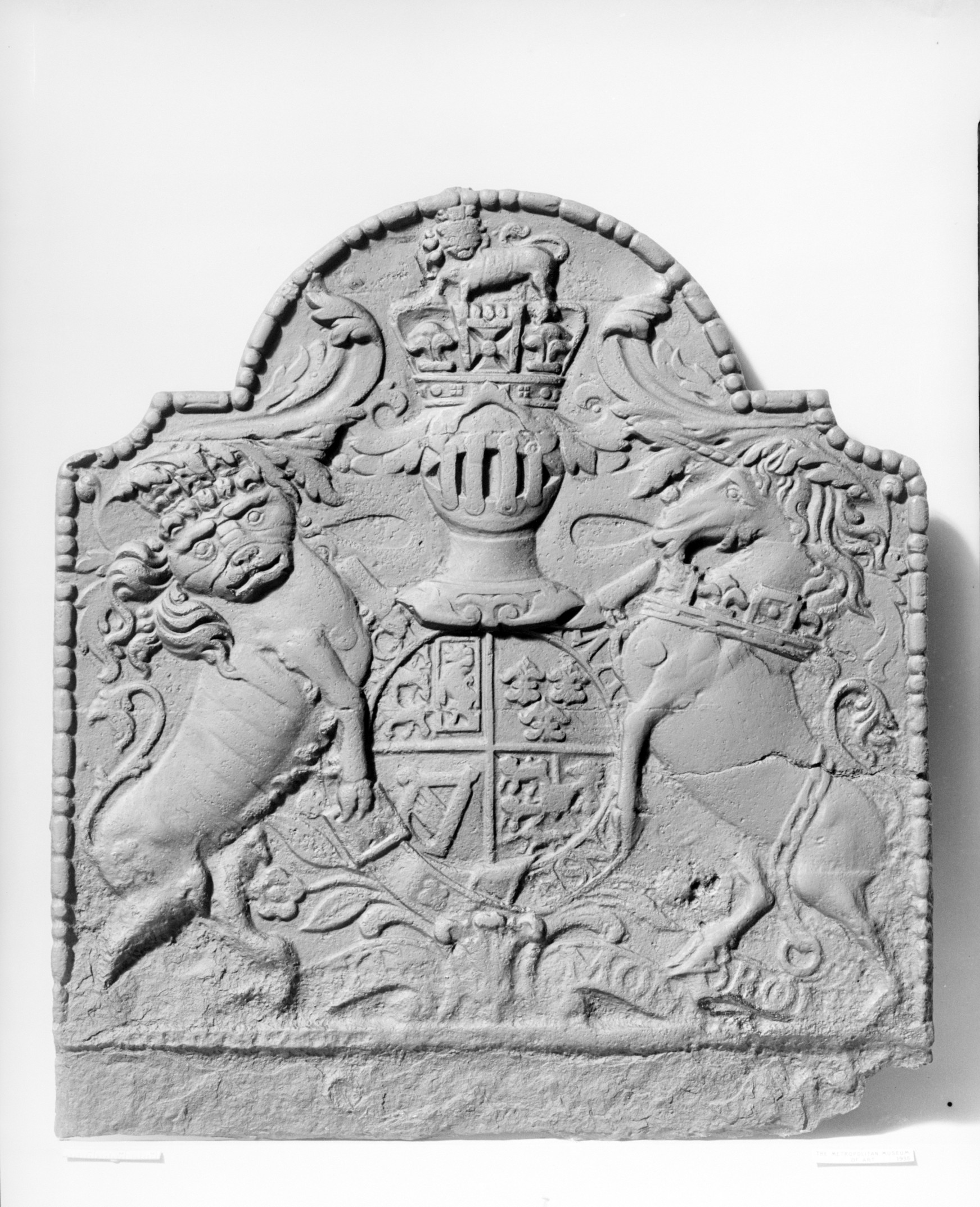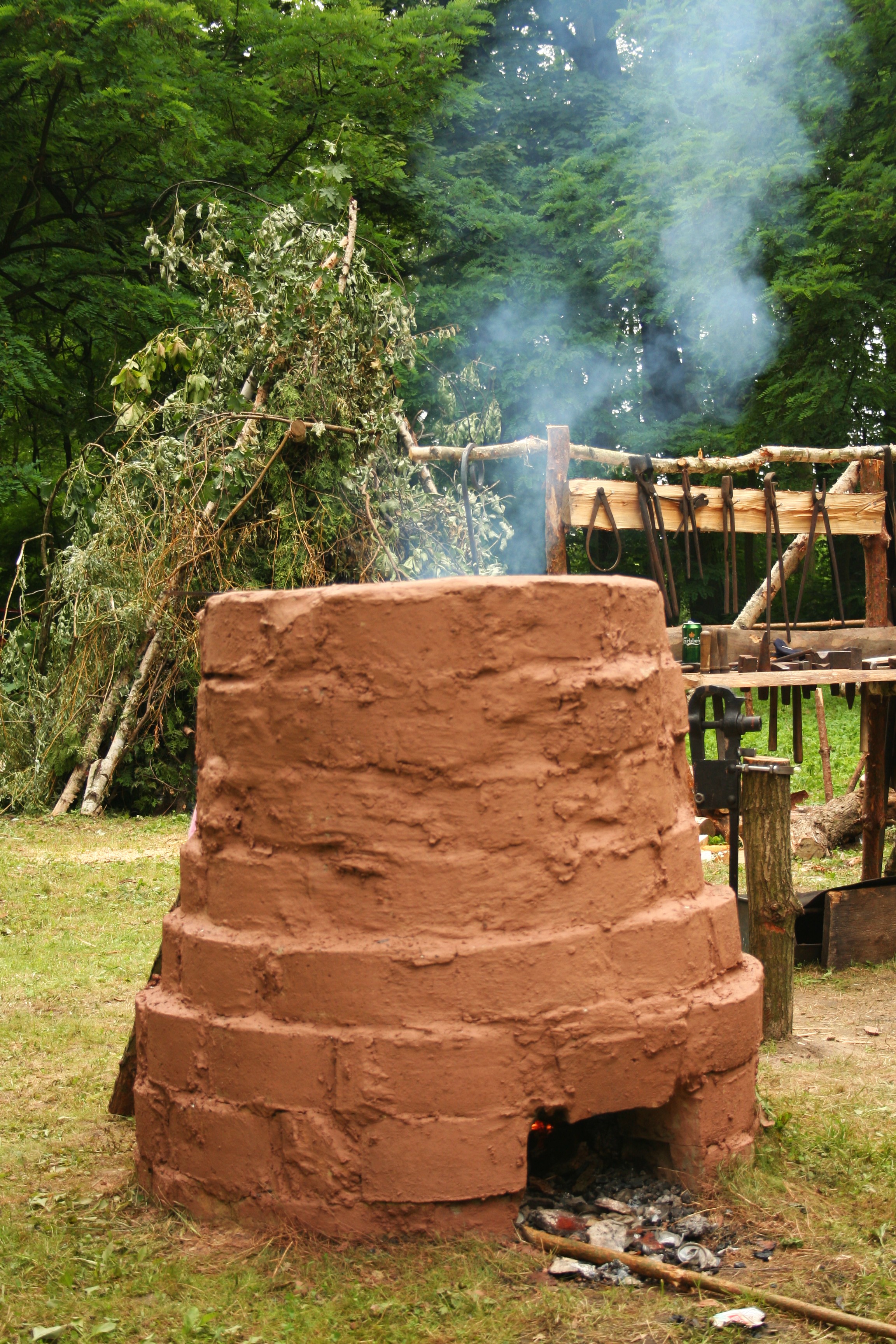|
Thomas Rutter
Thomas Rutter (1660 – March 12, 1730) was an American ironmaster and abolitionist who constructed the first blast furnace and the first iron forge in the Province of Pennsylvania. Now known as Pine Forge Mansion and Industrial Site, the location of Rutter's mansion and iron plantation was listed on the National Register of Historic Places in 2004. The site has been the campus of Pine Forge Academy since 1945. Biography Born in 1660, Rutter was a Quaker blacksmith who immigrated from England to southeastern Pennsylvania as a young man. He married Rebecca Staples at the Pennsbury Friends Meetinghouse on October 11, 1685, and acquired property near William Penn's Pennsbury Manor in Bristol Township. By January 1702, he had acquired over seven hundred acres with the goal of mining the soil for iron ore, though the venture failed. In a covenant dated February 12, 1715, Governor William Penn granted Rutter three hundred acres on Manatawny Creek two or three miles above modern-d ... [...More Info...] [...Related Items...] OR: [Wikipedia] [Google] [Baidu] |
England
England is a country that is part of the United Kingdom. It shares land borders with Wales to its west and Scotland to its north. The Irish Sea lies northwest and the Celtic Sea to the southwest. It is separated from continental Europe by the North Sea to the east and the English Channel to the south. The country covers five-eighths of the island of Great Britain, which lies in the North Atlantic, and includes over 100 smaller islands, such as the Isles of Scilly and the Isle of Wight. The area now called England was first inhabited by modern humans during the Upper Paleolithic period, but takes its name from the Angles, a Germanic tribe deriving its name from the Anglia peninsula, who settled during the 5th and 6th centuries. England became a unified state in the 10th century and has had a significant cultural and legal impact on the wider world since the Age of Discovery, which began during the 15th century. The English language, the Anglican Church, and Engli ... [...More Info...] [...Related Items...] OR: [Wikipedia] [Google] [Baidu] |
Pennsbury Manor
Pennsbury Manor is the colonial estate of William Penn, founder and proprietor of the Colony of Pennsylvania, who lived there from 1699 to 1701. He left it and returned to England in 1701, where he died penniless in 1718. Following his departure and financial woes the estate fell into numerous hands and disrepair. Since 1939 it has been the name of a reconstructed manor on the original property. Penn had his manor built on an parcel, part of his much larger grant of land from the Crown. It was located about 25 miles north of Philadelphia along the Delaware River in present-day Falls Township, Bucks County, Pennsylvania. In 1929 the Pennsylvania legislature authorized acquisition of the property by gift. In 1932 the Warner Company donated nearly ten acres of the property to the state of Pennsylvania as a site for a permanent memorial to Penn. The Pennsylvania Historical Commission was given responsibility for it. The legislature appropriated money to reconstruct the buildings o ... [...More Info...] [...Related Items...] OR: [Wikipedia] [Google] [Baidu] |
Pennsylvania Historical And Museum Commission
The Pennsylvania Historical and Museum Commission (PHMC) is the governmental agency of the Commonwealth of Pennsylvania responsible for the collection, conservation and interpretation of Pennsylvania's historic heritage. The commission cares for historical manuscripts, public records, and objects of historic interest; museums; archeology; publications; historic sites and properties; historic preservation; geographic names; and the promotion of public interest in Pennsylvania history. PHMC was established June 6, 1945, by state Act No. 446, merging the Pennsylvania Historical Commission (PHC), Pennsylvania State Museum and Pennsylvania State Archives. The commission is an independent administrative board, consisting of nine citizens of the Commonwealth appointed by the Governor; the Secretary of Education ex officio; two members of the Senate appointed by the President Pro Tempore and Minority Leader; and two members of the House of Representatives appointed by the Speaker and M ... [...More Info...] [...Related Items...] OR: [Wikipedia] [Google] [Baidu] |
Underground Railroad
The Underground Railroad was a network of clandestine routes and safe houses established in the United States during the early- to mid-19th century. It was used by enslaved African Americans primarily to escape into free states and Canada. The network was assisted by abolitionists and others sympathetic to the cause of the escapees. The enslaved persons who risked escape and those who aided them are also collectively referred to as the "Underground Railroad". Various other routes led to Mexico, where slavery had been abolished, and to islands in the Caribbean that were not part of the slave trade. An earlier escape route running south toward Florida, then a Spanish possession (except 1763–1783), existed from the late 17th century until approximately 1790. However, the network now generally known as the Underground Railroad began in the late 18th century. It ran north and grew steadily until the Emancipation Proclamation was signed by President Abraham Lincoln.Vox, Lisa"How D ... [...More Info...] [...Related Items...] OR: [Wikipedia] [Google] [Baidu] |
Fugitive Slaves In The United States
In the United States, fugitive slaves or runaway slaves were terms used in the 18th and 19th century to describe people who fled slavery. The term also refers to the federal Fugitive Slave Acts of 1793 and 1850. Such people are also called freedom seekers to avoid implying that the slave had committed a crime and that the slaveholder was the injured party. Generally, they tried to reach states or territories where slavery was banned, including Canada, or, until 1821, Spanish Florida. Most slave law tried to control slave travel by requiring them to carry official passes if traveling without a master. Passage of the Fugitive Slave Act of 1850 increased penalties against runaway slaves and those who aided them. Because of this, some freedom seekers left the United States altogether, traveling to Canada or Mexico. Approximately 100,000 American slaves escaped to freedom. Laws Beginning in 1643, the slave laws were enacted in Colonial America, initially among the New England Co ... [...More Info...] [...Related Items...] OR: [Wikipedia] [Google] [Baidu] |
Reading Eagle
The ''Reading Eagle'' is the major daily newspaper in Reading, Pennsylvania. A family-owned newspaper until the spring of 2019, its reported circulation is 37,000 (daily) and 50,000 (Sundays). It serves the Reading and Berks County region of Pennsylvania. After celebrating its sesquicentennial of local ownership and editorial control in 2018, the ''Reading Eagle'' was acquired by the Denver, Colorado-based MediaNews Group (also known as Digital First Media) in May 2019. History The newspaper was founded on January 28, 1868. Initially an afternoon paper, it was published Monday through Saturday with a Sunday-morning edition added later. In 1940, the ''Eagle'' acquired the ''Reading Times'', which was a morning paper, but they remained separate papers. The staff of the two papers was combined in 1982. In June 2002, the ''Reading Times'' ceased publication, and the ''Eagle'' became a morning paper. Both papers had been publishing a joint Saturday-morning edition since 1988. ... [...More Info...] [...Related Items...] OR: [Wikipedia] [Google] [Baidu] |
George Keith (missionary)
George Keith (1638/1639 – 27 March 1716) was a Scottish Presbyterian turned Quaker turned Anglican. He was born in Peterhead, Aberdeenshire, Scotland, to a Presbyterian family and received an M.A. from the University of Aberdeen. Keith joined the Religious Society of Friends (Quakers) in the 1660s, accompanying George Fox, William Penn, and Robert Barclay on a mission to the Netherlands and Germany in 1677. In 1685, three years after Barclay had been made the nonresident governor of the Province of East Jersey (part of the present-day American state of New Jersey), Keith traveled there to take the post of Surveyor-General. In 1686 he ran the first survey to mark out the border between West Jersey and East Jersey, which is today still known as the Keith line. Around 1691 Keith decided that Quakers had strayed too far from orthodox Christianity and began to have sharp disagreements with his fellow believers. He first broke with Philadelphia Yearly Meeting to form a shor ... [...More Info...] [...Related Items...] OR: [Wikipedia] [Google] [Baidu] |
Fireplace Fireback
A fireplace fireback is a piece of heavy cast iron, sized in proportion to the fireplace and the fire, which is placed against the back wall of the fireplace. Functions The primary functions of a fireback are to protect the wall at the back of the fireplace and radiate heat from the fire into the room. The protection was especially important where the wall was constructed of insubstantial material such as daub (a mud and straw mixture coating interwoven wooden wattles), brick or soft stone. Protective metal plates that became available when cast iron was developed enabled fires to be placed against walls without danger to the fabric of the building. The other function of the fireback is to act as a radiator of stored heat. The metal is heated by the fire, and then that heat is radiated into the room. The thick iron keeps the heat which would otherwise be lost and gives back this heat to the room. A fireback thus may increase the efficiency of the fire. Wood fires have low efficienc ... [...More Info...] [...Related Items...] OR: [Wikipedia] [Google] [Baidu] |
John Potts (Pennsylvanian)
John Potts (c. 1710 – 6 June 1768) was the founder of the town of Pottstown, Pennsylvania.History of Pottstown from Pottstown Official Website (accessed March 30, 2011) He was also an ironmaster, merchant, and English Quaker. John Potts, oldest son of Thomas and Martha (Keurlis) Potts, was born about 1710, probably in . He married Ruth Savage, daughter of Samuel and Ann (Rutter) Savage, on 11 April 1734. The marriage was accomplished after the manner of Friends, though not under their care or jurisdiction. J ... [...More Info...] [...Related Items...] OR: [Wikipedia] [Google] [Baidu] |
Jonathan Dickinson (New Jersey Minister)
Jonathan Dickinson (April 22, 1688 – October 7, 1747) was a Congregational, later Presbyterian, minister, a leader in the Great Awakening of the 1730s and 1740s, and a co-founder and first president of the College of New Jersey, which later became Princeton University. Biography Born in Hatfield, Massachusetts on April 22, 1688, Dickinson studied theology at the Collegiate School of Connecticut, later known as Yale College, graduating in 1706. In 1709, Dickinson was ordained minister of the Congregational church in Elizabethtown, New Jersey. Dickinson became concerned about the attempts of the established Church of England to suppress dissenters in New Jersey. Seeing a need for more coordination among dissenting churches, in 1717 Dickinson persuaded his congregation to join the Presbytery of Philadelphia. He became an active and influential participant in the affairs of the Presbyterians, and was twice elected moderator of the Synod of Philadelphia. As a former Congre ... [...More Info...] [...Related Items...] OR: [Wikipedia] [Google] [Baidu] |
Bloomery
A bloomery is a type of metallurgical furnace once used widely for smelting iron from its oxides. The bloomery was the earliest form of smelter capable of smelting iron. Bloomeries produce a porous mass of iron and slag called a ''bloom''. The mix of slag and iron in the bloom, termed ''sponge iron'', is usually consolidated and further forged into wrought iron. Blast furnaces, which produce pig iron, have largely superseded bloomeries. Process A bloomery consists of a pit or chimney with heat-resistant walls made of earth, clay, or stone. Near the bottom, one or more pipes (made of clay or metal) enter through the side walls. These pipes, called ''tuyeres'', allow air to enter the furnace, either by natural draught or forced with bellows or a trompe. An opening at the bottom of the bloomery may be used to remove the bloom, or the bloomery can be tipped over and the bloom removed from the top. The first step taken before the bloomery can be used is the preparat ... [...More Info...] [...Related Items...] OR: [Wikipedia] [Google] [Baidu] |
Germantown, Philadelphia
Germantown (Pennsylvania Dutch: ''Deitscheschteddel'') is an area in Northwest Philadelphia. Founded by German, Quaker, and Mennonite families in 1683 as an independent borough, it was absorbed into Philadelphia in 1854. The area, which is about six miles northwest from the city center, now consists of two neighborhoods: 'Germantown' and 'East Germantown'. Germantown has played a significant role in American history; it was the birthplace of the American antislavery movement, the site of a Revolutionary War battle, the temporary residence of George Washington, the location of the first bank of the United States, and the residence of many notable politicians, scholars, artists, and social activists. Today the area remains rich in historic sites and buildings from the colonial era, some of which are open to the public. Boundaries Germantown stretches for about two miles along Germantown Avenue northwest from Windrim and Roberts Avenues. Germantown has been consistently bounded ... [...More Info...] [...Related Items...] OR: [Wikipedia] [Google] [Baidu] |







